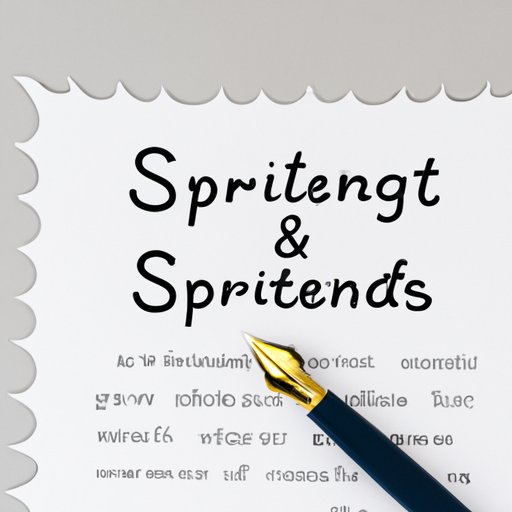
Introduction
Writing is an art as much as it is a craft, and ending a paragraph effectively is a skill that separates good writers from excellent ones. Concluding a paragraph requires thoughtfulness and careful consideration of how to leave an impact on the reader. It sets the tone and prepares the reader for what’s to come, and it also demands that the writer demonstrates their ability to convey ideas effectively.
In this article, we will discuss five proven techniques to end paragraphs like a pro. We will also explore the art of crafting the perfect paragraph ending and how to choose words carefully, tips, and strategies for concluding a paragraph strongly, the dos and don’ts, and even strategies for writing effective cliffhangers.
5 Proven Techniques for Concluding a Paragraph Like a Pro
Technique 1: Rephrase the main point of the paragraph
One easy technique for concluding a paragraph is to rephrase the main point of the paragraph, often in a more concise manner. This technique could help reinforce the focus of your idea to the reader.
For instance, if you are writing about a new product, you might summarize by stating, “In conclusion, Product X has been proven to have significant value in the market.”
Technique 2: Ask a thought-provoking question
Asking a question that sparks thoughts is another technique that can help your reader understand your content more deeply and contemplate the information provided.
For instance, if you are writing about healthy eating habits, conclude by asking, “What changes in your diet might you make today to improve your health?”
Technique 3: Use a relevant quote or anecdote
Using a relevant quote or anecdote often enhances the reader’s understanding and connection with what you are discussing. It can also make your content more interesting and attention-grabbing.
For instance, if you are writing about time management, you could use a quote like “Lost time is never found again,” by Benjamin Franklin to illustrate your point.
Technique 4: Provide a transition to the next paragraph
A smooth transition between paragraphs keeps the reader engaged and helps them follow your ideas.
For instance, if you are writing about traveling and your next paragraph is about your experiences in Europe, you might end your current paragraph by saying, “Before discussing my experiences in Europe, allow me to first describe how I arrived there.”
Technique 5: End with a future prediction or recommendation
A paragraph could conclude by including future predictions or recommendations. This type of conclusion could leave a lasting impression on the reader.
For instance, if you are writing about education, you might conclude by saying, “By focusing on and investing in education, we could work towards a brighter future for our younger generation.”
Mastering the Art of the Perfect Paragraph Ending
The final words of a paragraph are vital in leaving a lasting impression on the reader. Choosing those words with care could affect how the reader reads your article and how they comprehend your message.
Some tips for crafting perfect conclusions would be to ensure that what you are writing is clear and understandable, summarize the content in a short and concise manner, and connect your final words to the topic introduced in the previous passage.
For instance, if you are writing about the importance of being punctual, your final words could involve summarising some points made earlier, by saying something like, “Being punctual is important for positively reflecting on your work habits and could affect your willingness to achieve success in all other areas of your life.”
Closing the Curtain: Tips for Concluding Your Paragraph Strongly
A strong ending to a paragraph should aim to leave an impression on the reader, pose a question, or challenge them to think. Some strategies to adopt when concluding strongly include, choosing a memorable phrase. Using persuasive language, or even quoting a famous personality.
For instance, “It’s not who you are that holds you back, it’s who you think you’re not” – an example of a quote by author Denis Waitley, could be a powerful reminder to the reader.
The Dos and Don’ts of Ending a Paragraph: A Comprehensive Guide
The Dos & Don’ts guide is essential to consider when ending your paragraph, and some put together tips include avoiding fluff, being clear and concise, and ensuring that the conclusion ties to the introduction’s main idea.
For instance, if you are writing about the best ways to take action, your conclusion should be related to the subject matter and offer some solutions.
From Cliffhangers to Conclusions: Strategies for Writing Strong Paragraph Endings
There are several effective strategies for creating strong cliffhangers and conclusions. Some of these include generating suspense, using analogies, and posing thought-provoking questions that excite the reader and call them to action.
One example of creating an effective cliffhanger could be, “He opened the door and froze,” leaving your reader curious about what will happen next, making them eager to turn to the following paragraph.
Conclusion
Effective writing requires careful attention to detail, and anyone can become a great writer by following tips and techniques to end paragraphs like a pro. Choose phrases carefully, use persuasive language, and connect your ending to the primary subject matter to leave a lasting impression. By following the guidelines discussed in this article, you can start writing powerful and effective paragraph endings today.




